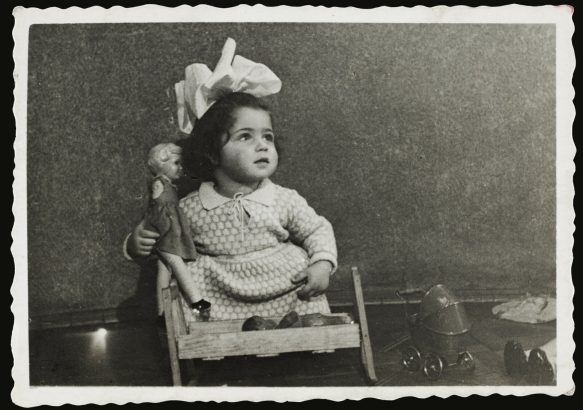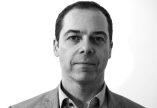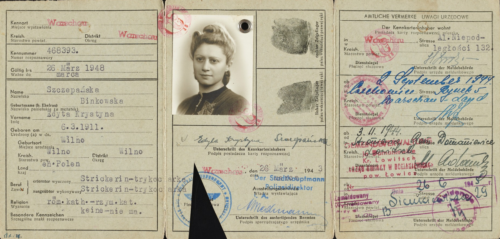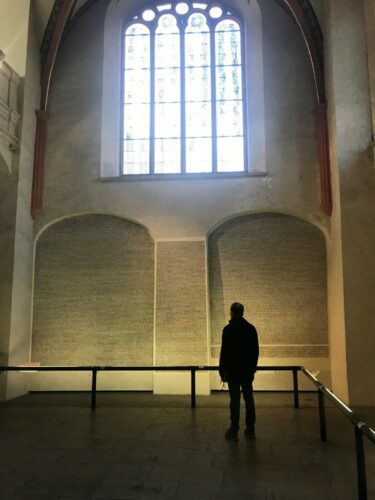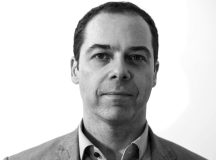Oliver Sears explores Holocaust memorialisation through the prism of his own remarkable and tragic family history. How best, he asks, do we honour and preserve history, in the 21st century?
Yom HaShoah, which fell on 23 April this year, was the first official Holocaust Memorial day, established in Israel in 1951 to commemorate the Warsaw Ghetto Uprising in 1943. It took another 54 years before the UN designated 27 January International Holocaust Memorial Day.
With extraordinary courage and, knowing that they could not possibly win, a group of young, poorly armed ghetto fighters defied the might of the SS for a month, stemming the continuous deportation of Jews from the ghetto to Treblinka, a death camp north of Warsaw where some 900,000 Jews were murdered in 18 months, gassed within 90 minutes of arrival. 90 per cent of the Warsaw ghetto was deported to Treblinka, where there were no more than 60 survivors. While their resistance was futile, the ghetto fighters bought the 55,000 remaining ghetto residents an extra month of life, a month which offered them their last winking ember of hope before the ghetto was finally liquidated and they, too, were deported to their deaths.
It was only much later in life that I made the connection between my grandmother Kryszia’s gift for sewing and her time as a forced labourer in one of the factories in the Warsaw Ghetto, making clothing for the Nazi war effort. Her infant daughter, my mother, hid at her feet while she worked, a situation that lasted for two years before they escaped on forged papers, shortly before the ghetto was liquidated.
Their story, like that of the ghetto fighters and all those who chose resistance by continuing to live, is a story of resilience, a word that has a particular meaning in families like mine. The Warsaw Ghetto represents the compressed history of the Holocaust, the gradual ratcheting up of cruelty, a Nazi experiment in social behaviour under increasing and relentless duress, including the murders of my great uncle and his eleven-year-old son, caught out in a wicked trap while convinced they were being exchanged for German prisoners. And my grandmother’s single-minded focus on saving her only child, my mother. The chances of escaping the Warsaw Ghetto with a four-year-old and surviving on the Aryan side were negligible.
This year, as Passover and Easter coincided, I reflected on how Holocaust memorialisation has become much more complex than constructing monuments to the dead and to the injustice that killed them. How have the overlapping concerns of personal remembrance, national memorial and education evolved over the last 80 years?
Holocaust commemorations are not only memorials; in many ways they are also funerals. They are funerals because there were no funerals. Funerals occur in all cultures, and Jews are no different. They acknowledge death, honour the deceased, and allow the process of mourning to begin. In this regard, the Holocaust is especially complicated for observant Jews, because the burial of the body is connected to the resting of the soul. The Yiddish word for soul is Noshome. Indeed, if you are having a blazing row with someone, firstly you give them achzig schwarz Juhr (eighty black years: that’s seventy, one for each year of your expected life span and another ten just in case). And then you take their Noshome out. Note, you’re not taking the head off or removing the heart, but extricating the soul. It’s the worst act you can commit. So how do we navigate the absence of six million funerals with all those souls adrift? How do we comprehend the impact and scale of the Holocaust?
My primary motivation in bringing awareness of the Holocaust to Ireland, where I live, flows from the impulse to honour my family. When I discovered that my maternal grandfather, Pawel Rozenfeld, was arrested at his factory, which manufactured stockings, and taken to Radogoszcz detention centre near Łódź in Poland in November 1939, tortured for eleven days, and murdered, I had the untidy responsibility of informing my mother. She knew nothing of these circumstances, having been told only that her father had disappeared at the beginning of the war and was never seen again. Pawel’s old factory is now being developed into 200 apartments, houses, and shops. My family will receive no compensation, an injustice that does not rankle much – the money was never mine, although the immorality of individuals, companies, and the Polish state profiting from his murder does sit starkly – in plain view in a shiny citadel of raw capitalism devoid of social, legal, and natural justice,.
The erasure of his name, however, I cannot countenance. To that end, I am working with the mayor’s office in Łódź to install a memorial plaque and a Stolperstein – a brass plaque embedded in the pavement, engraved with his name and place where he was murdered. This would be something of a coup. Within Poland’s borders, where five out of six Jews in the Holocaust were slain, there are barely forty Stolperstein out of the seventy thousand laid in twelve hundred cities across Europe. This decentralised form of memorialisation is not popular in Poland, where Polish Jews murdered in the Holocaust are traditionally counted not as Jewish victims but as Polish ones. When I mentioned the friendly overtures of the mayor’s office to a Polish lawyer I know who specialises in Holocaust era restitution, his response was, ‘it’s easy to be kind when one’s stomach is full’; a reference to Poland’s booming economy and a legal system making restitution virtually impossible. What harm a plaque when there’s no threat of losing the property?
New research suggests Pawel, my grandfather, may have been taken to Brus, 5km away, and shot on a military training ground. Polish authorities are excavating human remains. I will offer my DNA. Perhaps I will have a chance to bring him to England and bury him next to his wife. She is buried next to my adoptive grandfather, a Polish Jew who found himself stranded in London as the war broke out and never saw another member of his family again, including a pregnant wife. I am named after his brother, Olek, who was hidden in the crypt of a church by a friendly priest. When he was betrayed, the friend held back the Gestapo at the door just long enough for Olek to shoot himself. Courage, from the old French meaning heart, the seat of all feeling.
We may at last have a funeral for Pawel, a moment to restore some posthumous dignity – a small act of repair for my family and a chance to put a kink in the chaos of not knowing. And, in the Jewish tradition, allow his soul to rest. I am sure neither grandfather will object to sharing the burial plot in the cemetery in north London.
Today, Radogoszcz is a museum – a Jewish-owned textile factory before the Gestapo arrived; it was brutal even by their depraved standards. In the autumn, ‘The Objects of Love’ exhibition, which tells the story of my family, will be presented there. A place that dishonoured Pawel with such ignominy will bow its head to his memory. To bring this exhibition within the walls of the building that meted out such violence and injustice to my grandfather gives me a sense of re-wiring the past. I cannot turn back the clock, but I can pass some light through a dark recess, temporarily at least.
My mother, however, does not want her name included in any memorial in Poland where the blight of the Holocaust, coupled to cultural antisemitism, has crushed any sense of her place of origin as a homeland. For her, her name belongs in Yad Vashem, Israel’s Holocaust memorial centre in Jerusalem.
Simon Schama – public intellectual, broadcaster and doyen of Jewish history – recently presented a BBC documentary entitled ‘The Road to Auschwitz’. He takes us to Lithuania, the country of his mother’s people, before heading to Auschwitz. Remarkably, at eighty years of age, it’s his first trip there. The story of Lithuania’s Jews is especially harrowing. Some two hundred thousand were murdered, 96 per cent of the population – the single highest percentage in the Holocaust. The vast majority were murdered in the ‘Holocaust by Bullets’. In 1940 and ‘41, Lithuanian Jews were slaughtered with horrific cruelty – beaten and bludgeoned in the street, shot into pits and, in one appalling case, pumped with water from a hose. Schama’s broadcast bears witness to this history, an act of memorialisation that does not seek to escape or airbrush the horror. How this most articulate spokesperson on Jewish life grapples with the language, to express the shock of being at the sites of such personal horror, is perhaps the most moving aspect of the film. Here is a simple truth. All of us who endeavour to find the right words to describe our inherited Holocaust history struggle and stumble. It’s not that the words do not exist. Samuel Coleridge described poetry as the right words in the right order. But this reflected history leaves little opportunity for poetry.
How to memorialise?
National memorialisation is always freighted with controversy; there are different approaches. The Holocaust Memorial above the location of Hitler’s bunker, outside the Reichstag in Berlin, was constructed in 2003. Designed by Peter Eisenman, the 2,711 concrete slabs of differing heights are designed to quickly disorientate the visitor who walks between them, rather like a maze. The proposition is that once you lose your way, you can easily lose your identity. In an age of living witnesses and with unprecedented archival material available, I’m not susceptible to abstract symbolism where Holocaust memorialisation is concerned. I’m more concerned that people should learn the truth, not representations of the truth.
My first trip to Prague’s Jewish quarter in February left a disjointed impression. Here, several synagogues remain intact and form part of a tourist attraction, each a museum. The Spanish synagogue, so-called for its intricate Moorish-influenced interior, was used during the war as a warehouse for goods seized from Jews by the Nazis. Display cabinets show some religious objects, and photographs record Jewish life before the war.
The Pinkas synagogue has a staggering 80,000 names of murdered Jews inscribed on the walls, two thirds of the total Jewish population in Czech lands in 1939. A couple took a selfie opposite one bank of names, laughing and smiling. Are they on the right side of history, I wondered, or is this what the transition from living to received history looks like after eighty years of unprecedented peace in Europe, now in the age of the smart phone? Hitler had wished that the Jewish quarter of Prague be preserved as an example of an extinct culture. There remain only 3,500 Czech Jews today. The fact that these synagogues and others are perfectly preserved but without congregations, reminds us how close Hitler came to realising his goal. I felt as if I was on an Inca trail, but I’m not an Inca: I am alive, and so is Judaism. This is memorialisation as someone else’s cultural curiosity.
In the UK, a debate about the construction of a Holocaust memorial in Westminster, in central London, to include a learning centre on genocide, has been swirling for years. Anita Lasker-Wallfisch, a London based Auschwitz survivor, suggests that if, after 80 years, we are still killing each other, another memorial will not make a difference. She feels that a new Jewish Museum dedicated to all Jewish history should include the Holocaust but also show how Jews lived. I agree; memorials should commemorate death and celebrate life.
At Babyn Yar, outside Kyiv, where 34,000 Jews were shot to death in a ravine over two days in 1941, plans for a memorial centre, with a museum, research centre, archive and synagogue, have been frozen since the Russian invasion. More than a million Jews were murdered on Ukrainian soil during the Holocaust. Uncomfortably, some of the perpetrators were Ukrainian. That a memorial centre, situated at the epicentre of this immeasurably complicated history, is prepared to navigate such charred terrain, underscores Ukraine’s heroic efforts to break free from its darkest history, exemplified by the determination of President Zelenskyy, a Jewish man of rare courage. How Putin defiles the memory of Babyn Yar with fresh blood, here of all places, shows not just moral collapse but contempt for morality itself – a kind of Holocaust anti-memorialisation.
Yad Vashem (meaning a memorial and a name), established in 1953, holds the names of 4 million victims. It is a solemn place of remembrance, an education centre and an archive. As with Auschwitz Memorial, which manages the camp site and museum, its role is to protect the memory of the victims and promote Holocaust education; both institutions work tirelessly to combat Holocaust denial and distortion – rising trends, despite the expansion of Holocaust education. A complicated dissonance explained predominantly by the proliferation of online conspiracy theory; the two most trafficked subjects: Jews and the Holocaust.
The model of a museum or learning centre on the site of a former camp or atrocity allows room for information and reflection, where memorialisation embraces both remembrance and education. As Anita Lasker-Walfisch points out, antisemitism is on the rise. What must it be like to be a 99-year-old Auschwitz survivor, who was forced to play the cello while her fellow Jews lined up on the selection ramp, to make that statement? My generation must not merely commemorate the dead. We must honour and protect their memory in death. We should link arms with the children of perpetrators, those victims born on the wrong side of history and, with them, resist the forces and impulses which created the environment that led to the disintegration of democracy in Germany eighty years ago, the normalisation of racist ideology and language, and the supremacy of a super-charged identity politics, forces which are gathering momentum once again. We understand how populism leverages grievance and how, one way or the other, the Jews are blamed for all society’s ills. We must promote a form of Holocaust memorialisation to counter this current culture of fear.
The Holocaust divided its witnesses into three groups: perpetrators (the smallest group), victims (a much larger group) and bystanders (the largest group of all); all three groups are implicated. But so dense is the darkness of this history that anyone who studies or encounters it also becomes a witness and is implicated, too – a new witness to the mystery and the horror, with the responsibility to recount its history honestly. And there lies a fork in the road: to look away, forget and allow time to consume this still living history, or to remember, confront and honour. This is the true value of Holocaust memorialisation.

